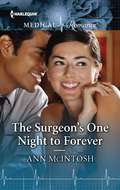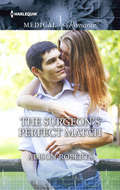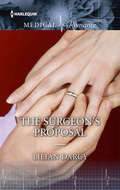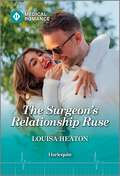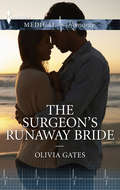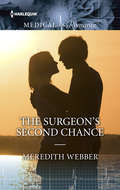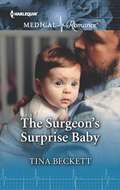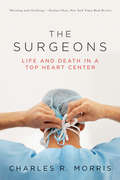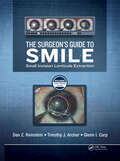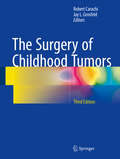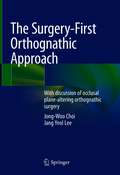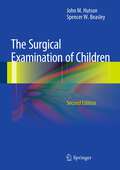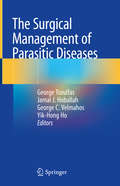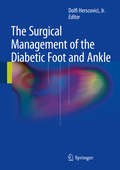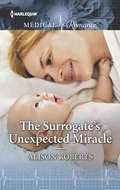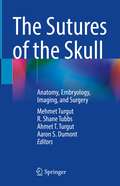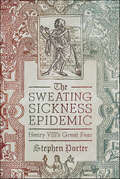- Table View
- List View
The Surgeon's One Night to Forever (Mills And Boon Medical Ser.)
by Ann McIntoshRead this classic romance by USA TODAY bestselling author Carole Mortimer, now available for the first time in e-book!He’ll settle for nothing lessAfter years of watching her mother’s gullible heart drive her from one man to the next, Laurel has decided to marry for sensible reasons. She doesn’t believe in fairy tales, knights in shining armour or happy endings.So, when her ‘safe’ fiancée breaks up with her on the night of their engagement party, she’s surprised to be rescued by her own knight, Reece Harrington. Laurel has always avoided the attraction between her and Reece. He wants way more than Laurel can give—total possession…!Originally published in 1985
The Surgeon's One-Night Baby: The Surgeon's One-night Baby / The Nurse's Pregnancy Miracle (Mills And Boon Medical Ser.)
by Charlotte HawkesA desire they can’t resist…A consequence they’ll cherish foreverStill reeling from her failed marriage, Archana Coates is ready to rediscover the vibrant, fun-loving woman she once was. So an unexpected encounter with her childhood crush, playboy surgeon Kaspar Athari, leads to temptation she can’t resist… Then Archie arrives in LA—pregnant! And when she and Kaspar discover their baby is at risk, Archie will do anything it takes to fight for her new little family.
The Surgeon's Perfect Match
by Alison RobertsBeautiful and talented registrar Holly Williams needs a kidney transplant and only one person can help her. Her boss -- pediatric cardiac surgeon Ryan Murphy. Ryan is Holly's perfect match in every sense. He has already fallen in love with her and he'll do anything to save her life...if only he can persuade her to let him.
The Surgeon's Proposal
by Lilian DarcySister Annabelle Drew had been shattered when one of her guests cried, "Stop the wedding"--just as she'd been about to say "I do." Surgeon Dylan Calford had no regrets --he was convinced that Annabelle's groom was completely wrong for her--until he discovered just how badly Annabelle needed her marriage of convenience. He proposed that he be her groom, instead. Annabelle didn't take gorgeous, athletic Dylan seriously, but that got them both thinking--was Dylan her Mr. Right...?
The Surgeon's Relationship Ruse
by Louisa HeatonA duke fake dates his new nurse colleague to quiet his family&’s judgment, but what happens when their relationship ruse starts to heal their old scars? Find out in Louisa Heaton&’s latest Harlequin Medical Romance! FAKING IT WITH HER HERO! Surgeon Anthony Fitzpatrick, Duke of Weston, is expecting a normal day on the orthopedic ward when he meets nurse Julia. He immediately recognizes her as the woman whose baby he unexpectedly delivered a decade ago! Since then, tragedy has devastated both their lives and left them guarded. Yet Julia still longs to repay Anthony for his kindness. So when he needs a fake relationship to appease his family&’s meddling, she steps up! But as their ruse unveils an all-too-real connection, can their two broken hearts heal as one?From Harlequin Medical: Life and love in the world of modern medicine.
The Surgeon's Rescue Mission
by Dianne DrakeSolaina Léandre saved Dr. David Gentry's life when she found him injured near the Dharavaj jungle. As she nursed him back to health, he nurtured feelings in her she'd never known--so why did he leave without a trace? Going against every cautious instinct, Solaina tracks him down at his hospital--and finds him in a situation that could cost him his life, and the lives of his patients! David knows that becoming involved with Solaina will put her in danger, but as the dedicated surgeon fights for his patients' lives, he finds he's fighting for the love of this beautiful nurse, as well.
The Surgeon's Runaway Bride
by Olivia GatesHer boss and husband Walking away from her husband, surgeon Roque Aguiar Da Costa, was the hardest thing Jewel Johanssen had ever done. After the loss of their baby and her subsequent infertility, Jewel was too hurt to see the truth--that Roque loved her above everything. Now Roque has tracked her to the Amazon rainforest, claiming that he's her boss and she's still his wife. Roque's seduction is a taste of heaven that slowly breaks Jewel's barriers down, allowing her to understand that the only thing she needs in order to heal is what she ran from in the first place--his love!
The Surgeon's Second Chance
by Meredith WebberComing soon! The Surgeon's Second Chance by Meredith Webber will be available Jan 21, 2017.
The Surgeon's Secret
by Lucy ClarkA forbidden desire...Dr. Alex Page wasn't quite sure how to handle gorgeous live wire Jordanne McElroy. The beautiful researcher was everything he had ever wanted in a woman, but he knew he couldn't risk getting involved. Jordanne, however, was determined to break down his resolve, and as she got closer to his heart, Alex realized she was also getting closer to the truth. To the secret he was convinced would lose him Jordanne....
The Surgeon's Surprise Baby: Pregnant With Her Best Friend's Baby (rescue Docs) / The Surgeon's Surprise Baby (Harlequin Lp Medical Ser. #Vol. 1034)
by Tina BeckettHe doesn’t believe in second chances...Until one knocks on his door!When neurologist Luca Venezio’s romance with surgeon Elyse Tenner ended as passionately as it began, he returned to Italy little knowing he’d left part of himself behind… Until Elyse arrives from America with their baby daughter and upends his world! Luca’s rocked by the bond with his little girl and how much he’s missed Elyse. Can they overcome the distance between them that’s more than merely miles?“What an emotionally-charged, fast-paced, entertaining read Ms. Beckett has delivered…the romance was wonderful and had me loving these two together....”— Harlequin Junkie on The Billionaire’s Christmas Wish“I have become a fan of Ms. Beckett’s medical romances and this is the best one I’ve read yet. As for the dialogue, it was very entertaining…the chemistry between this couple was powerful and just kept getting stronger the more they interacted….”— Harlequin Junkie on Tempted by Dr. Patera
The Surgeons: Life and Death in a Top Heart Center
by Charles R. Morris"Insightful and filled with verve...electrifying."--Wall Street Journal Hailed as "an astute book of enormous importance" (Sherwin Nuland), The Surgeons follows the team at one of the world's premier cardiac surgery and transplant centers. Given unprecedented access, Charles R. Morris recounts in thrilling detail a late-night against-the-clock "harvest run" to secure a precious transplantable organ, the heartbreaking story of a child's failed transplant, and more. Along the way, Morris reflects on how doctors really think, rising health care costs, and the future of health care in America.
The Surgeon’s Guide to SMILE: Small Incision Lenticule Extraction
by Dan Reinstein Timothy Archer Glenn CarpCorneal refractive surgeons are likely already familiar with the theory behind small incision lenticule extraction (SMILE) and the excellent postoperative outcomes it can achieve, but they were left without a thorough and comprehensive guide to performing the procedure, until now. The Surgeon’s Guide to SMILE: Small Incision Lenticule Extraction is designed to provide surgeons who are interested in starting or are already performing SMILE with a detailed description of the preoperative assessment, surgical technique, and postoperative management of SMILE treatments.This book by Professor Dan Z. Reinstein, Mr. Timothy J. Archer, and Dr. Glenn I. Carp is designed as a surgical video-fellowship, focusing on the granular details of every aspect of patient preparation and management with special attention to how to perform a perfect routine SMILE procedure. The protocols and methods are sourced in both the published scientific evidence and the extensive experience and expertise of the authors. It also includes tips and tricks of how to manage the full range of possible scenarios and complications that can occur during and after a SMILE surgery. Each process described in the book is accompanied by at least one, and in many cases numerous, narrated video examples.Bonus!This dynamic learning tool is supplemented by the SMILE video library containing over 16 hours of surgical videos and tutorials hosted on a companion website.The succinct and demonstrative style of The Surgeon’s Guide to SMILE: Small Incision Lenticule Extraction will help novice and experienced SMILE surgeons alike learn important techniques and improve their outcomes.From the Foreword:“The reader is in for a treat, receiving authoritative technical information from seasoned leaders in the field of refractive surgery, who have attained tremendous experience in excimer laser ablation and who have also been on the forefront of scientific evaluation of the new femtosecond only surgical approach that is SMILE.”-J. Bradley Randleman, MD, University of Southern California, Los Angeles, CA
The Surgery of Childhood Tumors
by Robert Carachi Jay L. GrosfeldBeginning with the scientific basis of tumors, this book provides up-to-date information on epidemiology, cytogenetics, and molecular biology, before examining current treatments for the full range of pediatric tumors. Integration of surgery, neoadjuvant and adjuvant chemotherapy, and radiation therapy is a dominant theme. In addition, chapters on supportive care, palliative care, and the role of parents' associations reflect the book's holistic approach. All chapters are written by world-renowned international authorities on pediatric cancer from major children's cancer groups. Excellent full-color pictures and line drawings illustrate all aspects of managing childhood tumors, including details of operative techniques neglected in many other texts. This comprehensive book, expanded and updated to encompass the very latest developments and strategies, provides a contemporary approach for pediatric, general, and urological surgeons dealing with childhood tumors.
The Surgery-First Orthognathic Approach: With discussion of occlusal plane-altering orthognathic surgery
by Jong-Woo Choi Jang Yeol LeeThis book is a comprehensive guide to the surgery-first orthognathic approach for patients with malocclusion and skeletal disharmony, which has been successfully applied by the authors in their practices over the past 15 years. The approach breaks with the time-tested principles of traditional orthognathic surgery in that corrective bone surgery is performed first, without the removal of dental compensations, followed by orthodontic finishing. All aspects are covered with the aid of numerous illustrations, the aim being to provide surgeons with a systematic educational tool that will enable them to introduce the approach into their own practice. In addition, the book addresses one of the hot issues in orthodontics, occlusal plane-altering orthognathic surgery, in which surgical modification of the occlusal plane is employed to treat various types of dentofacial deformity and improve facial proportions. This promises to become a very powerful tool in modern orthognathic surgery.
The Surgical Examination of Children
by John M. Hutson Spencer W. BeasleyThis book demonstrates clearly how to perform a clinical examination in the infant or child with a surgical condition. While most textbooks of pediatric surgery focus on the pathological classification and overall management of disease, in clinical practice physicians and surgeons usually use a problem-oriented approach to clinical diagnosis. Surprisingly, this is rarely taught to students. The authors attempt to redress this imbalance by providing a clinical approach to the patient which can be learned with a minimum of factual information. The book should therefore remain useful to the practitioner throughout his or her medical career. It includes detailed coverage of the usual presentations of common diseases, but does not attempt to cover all aspects of the presentations of uncommon diseases unless their recognition is important for the well-being or survival of the child. Generously illustrated, this is a book for all who are learning the art of pediatric surgical diagnosis.
The Surgical Management of Parasitic Diseases
by Jamal J. Hoballah George C. Velmahos George Tsoulfas Yik-Hong HoThis book is designed to present a comprehensive and state-of the-art approach to the diagnosis and surgical management of parasitic diseases involving different organ systems, with emphasis on the gastrointestinal tract. It is divided into five parts that address the various etiologies, current diagnostic dilemmas and methods, as well as the key principles involved in their surgical management. The introduction presents the overall epidemiology and classification of parasitic diseases, followed by chapters that focus on different types of the most frequently encountered parasitic diseases of the gastrointestinal tract found in different parts of the world, with special attention given to the existing surgical debates regarding the use of minimally invasive procedures. The next part places special emphasis on hydatid disease by describing the current extent of this disease, changes in its management, and the most frequent complications and tips on how to avoid them. The following part discusses the surgical management of parasitic diseases affecting different organ systems, including the heart, the lungs, the brain and the urinary system. The final part presents the surgical dilemmas encountered in special situations, such as pregnancy, and the pediatric patient. The Surgical Management of Parasitic Diseases is an important and authoritative resource to surgeons of all specialties dealing with parasitic diseases
The Surgical Management of the Diabetic Foot and Ankle
by Dolfi HerscoviciOffering up-to-date guidance to surgeons looking for the most current management for the care of Charcot arthropathy and related fractures of the foot and ankle in diabetic patients, this book discusses pathophysiology, recommendations for pre-surgical evaluations, and management strategies for diabetes and Charcot neuroarthropathy, along with demographics and epidemiology of diabetes. Conservative care, total contact casts and footwear are discussed, as well as the management of infections and osteomyelitis. Acute fractures and Charcot arthropathy for the forefoot, midfoot and ankle follow, including plate and axial fixation techniques, with authors' preferred treatment strategies presented in step-by-step fashion. Written and edited by recognized leaders in the field, this is a must-have for orthopedic surgeons and podiatrists, residents, nurse practioners, physician's assistants and all people treating diabetic patients and will be an excellent resource for treating these debilitating afflictions.
The Surrogate's Unexpected Miracle
by Alison RobertsTheir unexpected family Ellie Thomas was meant to be a surrogate mother to the baby growing inside her, but when her best friend abandons her, everything changes. The moment her son is born, Ellie knows she could never give him up! But the one person she can turn to for help is the doctor who delivered her child. Dr. Luke Gilmore didn't have a picture-perfect childhood, but he instinctively wants to protect Ellie and her baby. He was only passing through, but he may have just found a reason to stay...
The Surrogate: A Novel
by Judith Henry WallTo a penniless twenty-year-old like Jamie Long, surrogate motherhood seemed both an act of altruism and a financial opportunity. But once pregnant and under contract to Amanda Hartmann, the head of a famous evangelical family, Jamie realizes that she's getting more than she bargained for. Whisked away to the vast, isolated family ranch, she's closely supervised and carefully cut off from the outside world. She learns the family's dark secrets -- and sees the enormity of their ruthlessness. When Jamie hears Amanda's plan to claim the baby as her natural-born child, she begins to suspect that her own life is in danger and resolves to flee. Alone with a tiny newborn, she calls on the one man in the world she can trust -- her high school crush, Joe Brammer. Their love unites them in a struggle to escape, and soon enough their flight becomes a fight for their lives. Brilliantly weaving some of today's most controversial social issues into a captivating page-turner,The Surrogateis Judith Henry Wall's greatest triumph to date.
The Survival Medicine Handbook: The Essential Guide For When Help Is Not On The Way
by Joseph Alton Amy AltonBlack & White Version. If a disaster took away the high-technology we take for granted, would you be prepared to keep you family healthy? Could you be an effective medic when hospitals are overcrowded and the ambulance is heading in the other direction? Can you take over if you were the highest medical asset left? Medical preparedness advocates Joe Alton, MD and Amy Alton, NP’s award-winning “Survival Medicine Handbook: A guide for when help is NOT on the way” is now out in its greatly expanded and revised 4th edition! Previous editions have been 1st place winners in the Book Excellence Awards in Medicine, and this one has many more topics and almost triple the illustrations to give you the info needed to keep it together, even when everything else falls apart. Called “America’s favorite survival medic” by American Outdoor Guide, NY Times/Amazon bestselling author Dr. Joe Alton and Nurse Practitioner Amy Alton have put together a 700 page book that encompasses trauma care, first aid, chronic care, medical procedures, and much more. It’ll be an essential reference for anyone concerned about the uncertain future. The Survival Medicine Handbook is written in plain English that anyone can understand, but it’s not just another medical first aid book. It’s unique in that it assumes that a disaster, natural or man-made, has removed all access to hospitals or doctors for the foreseeable future; you, the average person, are now the highest medical resource left to your family. The book’s goal is to make you effective in that role.
The Suspect: The white-knuckle thriller behind the ITV series (Joe O'Loughlin #1)
by Michael RobothamThe first book in the Joe O'Loughlin series, from the multi-million-copy bestselling author. NOW A MAJOR ITV DRAMA STARRING AIDAN TURNER.Liar, liar . . .Joe O'Loughlin appears to have the perfect life - a beautiful wife, a loving daughter and a successful career as a clinical psychologist. But nothing can be taken for granted. Even the most flawless existence is only a loose thread away from unravelling. All it takes is a murdered girl, a troubled young patient and the biggest lie of his life. Caught in a complex web of deceit and haunted by images of the slain girl, he embarks upon a search that will take him from London to Liverpool and into the darkest recesses of the human mind. Ultimately, he will risk everything to unmask the killer and save his family.Don't miss the #1 bestseller's new thriller When You Are Mine, out now.Praise for Michael Robotham's thrillers:'I love this guy's books' Lee Child'Will have you turning the pages compulsively' The Times'An absolute master' Stephen King'He writes in a voice with a haunting sense of soul' Peter James'Heart-stopping and heart-breaking' Val McDermid'The real deal' David Baldacci'Superbly exciting . . . a terrific read' Guardian
The Suspect: The white-knuckle thriller behind the ITV series (Joseph O'Loughlin #1)
by Michael RobothamThe first book in the Joseph O'Loughlin series, from the multi-million-copy bestselling author. Don't miss Michael Robotham's new thriller When She Was Good, out now.Liar, liar...Joseph O'Loughlin appears to have the perfect life - a beautiful wife, a loving daughter and a successful career as a clinical psychologist. But nothing can be taken for granted. Even the most flawless existence is only a loose thread away from unravelling. All it takes is a murdered girl, a troubled young patient and the biggest lie of his life. Caught in a complex web of deceit and haunted by images of the slain girl, he embarks upon a search that will take him from London to Liverpool and into the darkest recesses of the human mind. Ultimately, he will risk everything to unmask the killer and save his family.Praise for Michael Robotham's thrillers:'I love this guy's books' Lee Child'Will have you turning the pages compulsively' The Times'An absolute master' Stephen King'He writes in a voice with a haunting sense of soul' Peter James'Heart-stopping and heart-breaking' Val McDermid'The real deal' David Baldacci'Superbly exciting . . . a terrific read' Guardian
The Sutures of the Skull: Anatomy, Embryology, Imaging, and Surgery
by R. Shane Tubbs Mehmet Turgut Ahmet T. Turgut Aaron S. DumontThis book provides an in-depth review of the sutures of the skull. The premature closure of the sutures of the skull (craniosynostosis) due to genetic or metabolic etiologies results in typical progressive skull deformity, due to both the inhibition of growth caused by the affected cranial suture and associated compensatory expansion of the skull along the open ones. Today, it is well known that early diagnosis of craniosynostosis is crucial for the best surgical outcomes and for the normal development of the brain and cosmetic appearance of the skull. As such, in addition to the anatomy, biology, genetics and embryology of the sutures of the skull, the book also covers the diagnosis and treatment of different forms of craniosynostosis such as metopism, and animal models for cranial suture research.This comprehensive work is a valuable resource for neuroscientists at all levels, from graduate students to researchers, as well as neurosurgeons, neuroanatomists, pediatricians, and neurologists seeking both basic and more advanced information on the unique structure of the sutures of the human skull.
The Sweating Sickness Epidemic: Henry VIII's Great Fear
by Stephen PorterAmong the array of diseases which brought death to Tudor England, the sweating sickness stood out, for the speed with which it struck, its dreadful effects on its victims and the death rates which it produced, that together generated a fear verging on panic when it was identified. The sweating sickness attacked the cities, towns and the countryside, not sparing the palaces. It threatened everyone, from the king in his castle to the beggars at his gates, including members of the dynasty and the political structure, the courtiers and those who directed the government, the church and the law. Contemporaries could do little more than make a bolt for it, and that included the king and his closest advisors, who moved furtively in a small group from one house to another away from London. The principal epidemics came between 1485, when it made its first appearance, and 1551, and it was confined to England and Wales, apart from one major eruption across northern Europe in 1529. Known as the English disease, this rapidly acting virus became Henry VIII’s overriding fear, aggravating his well-known hypochondria and controlling his movements. The nature of the sweating sickness, its incidence and impact are all examined in this book, in the context not only of Tudor England and the problems of the Henrician succession, but also in the context of epidemic disease in Europe more widely. This book teases out the similarities and differences between ‘the sweat’ and its better-known, if equally feared, contemporary infectious disease, bubonic plague.
The Sweet Life: Diabetes without Boundaries
by Sam TalbotSam Talbot is a professional chef, restaurateur, surfer, painter, philanthropist, and, since the age of 12, type 1 diabetic. Yet he has not let the disease stop him from living a rich life packed with energy, adventure, and achievement--culinary and otherwise. In his first, much-anticipated book, he recounts how diabetes has affected but not compromised his life or career, and he shares his own tips--alongside those from other famous diabetics like Halle Berry, Larry King, and Tommy Lee--on how to handle everything from work and hobbies to relationships and travel with discipline and enthusiasm. To round out this advice, he offers bits of foodie wisdom and 75 innovative recipes for fresh, all-natural dishes anybody, diabetic or not, can prepare and enjoy. Heartfelt, entertaining, and backed by real-life experience and solid medical expertise, The Sweet Life will give readers hope, inspiration, and the proof they need to realize that life with diabetes isn't about diabetes: It's about living.
